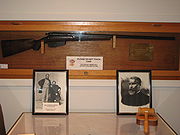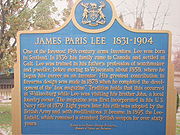.gif)
John Lee (Inventor)
Encyclopedia
John Lee was a Scottish-Canadian - Canadian inventor and arms
designer, best known for co- inventing a prototype bolt action rifle with his brother James Paris Lee
. The rifle they made led to the Lee-Metford
and Lee-Enfield
series of rifle
s.
Harrowing from Hawick
, Scotland
the Lee family emigrated to Ontario
in Canada
c.1835. After John grew up he moved to a small town along the Sydenham River
called Wallaceburg.
http://www.kent.net/wallaceburg-museum/flashindex.html.

, Chatham-Kent’s M.P.P. corresponded. The letters discussed the possibility of erecting a plaque to commemorate the first test shot of the Lee rifle in Wallaceburg. The two discovered that they needed the approval of the Archaeological and Historic Sites Board of Ontario (A.H.S.B.O.) to get official historic site designation.
Historians and dignitaries such as J.M.S. Careless, Richard Apted, Harry Pietersma and James Auld
helped research and facilitate the investigation. In over a decade of study few documents were found to substantiate that the first shot occurred in Wallaceburg. Nonetheless, the A.H.S.B.O. recognized that there was a vast amount of other evidence that could not be ignored. Most of the testimonials came from oral history passed down through the decedents of James Paris and John Lee. In 1975, they erected a plaque in civic park that stated, “Tradition holds that this (the first firing) occurred at Wallaceburg while Lee was visiting his brother John, a local foundry owner.” The plaque is located in Civic Park close to the original location of John Lee’s foundry.
It is believed that the first shots occurred just outside the Lee Foundry. The target was an oak tree, on the South Side of Wallaceburg, across the Sydenham River.
Eugene Myszkowski, a Lee Rifle Historian, and expert on the topic had an interesting find when he examined “the prototype”. In his opinion the rifle pre-dates the Borchardt
patent of 1882. The museum prototype is different from post-Borchardt patent rifles because it has a riveted magazine spring. Myszkowski outlines how post-Borchardt rifles were different: “[They] solder[ed] two stamped shells together, using a riveted magazine spring and a shallow magazine catch notch in the rear rip. The cartridge guide grooves were only on the upper rear of the magazine.”
The museum prototype has none of the later specifications. Given Myszkowski’s patent information and the oral testimony of the Lee family it is reasonable to assume that this rifle is “the prototype” and was created in 1878.
Weapon
A weapon, arm, or armament is a tool or instrument used with the aim of causing damage or harm to living beings or artificial structures or systems...
designer, best known for co- inventing a prototype bolt action rifle with his brother James Paris Lee
James Paris Lee
James Paris Lee was a Scottish-Canadian and later American inventor and arms designer, best known for inventing the bolt action that led to the Lee-Metford and Lee-Enfield series of rifles.-Early Life and Career:...
. The rifle they made led to the Lee-Metford
Lee-Metford
The Lee-Metford rifle was a bolt action British army service rifle, combining James Paris Lee's rear-locking bolt system and ten-round magazine with a seven groove rifled barrel designed by William Ellis Metford...
and Lee-Enfield
Lee-Enfield
The Lee-Enfield bolt-action, magazine-fed, repeating rifle was the main firearm used by the military forces of the British Empire and Commonwealth during the first half of the 20th century...
series of rifle
Rifle
A rifle is a firearm designed to be fired from the shoulder, with a barrel that has a helical groove or pattern of grooves cut into the barrel walls. The raised areas of the rifling are called "lands," which make contact with the projectile , imparting spin around an axis corresponding to the...
s.
Harrowing from Hawick
Hawick
Hawick is a town in the Scottish Borders of south east Scotland. It is south-west of Jedburgh and south-southeast of Selkirk. It is one of the farthest towns from the sea in Scotland, in the heart of Teviotdale, and the biggest town in the former county of Roxburghshire. Hawick's architecture is...
, Scotland
Scotland
Scotland is a country that is part of the United Kingdom. Occupying the northern third of the island of Great Britain, it shares a border with England to the south and is bounded by the North Sea to the east, the Atlantic Ocean to the north and west, and the North Channel and Irish Sea to the...
the Lee family emigrated to Ontario
Ontario
Ontario is a province of Canada, located in east-central Canada. It is Canada's most populous province and second largest in total area. It is home to the nation's most populous city, Toronto, and the nation's capital, Ottawa....
in Canada
Canada
Canada is a North American country consisting of ten provinces and three territories. Located in the northern part of the continent, it extends from the Atlantic Ocean in the east to the Pacific Ocean in the west, and northward into the Arctic Ocean...
c.1835. After John grew up he moved to a small town along the Sydenham River
Sydenham River
The Sydenham River is a river in Kent County, Lambton County and Middlesex County in southwestern Ontario, Canada, flowing southwest from its source west of London, Ontario and emptying into Lake Saint Clair. The length of the river is and it drains a watershed of approximately 2,700 square...
called Wallaceburg.
The Lee Rifle's Beginning
In 1878, Lee and his brother James Paris perfected a rifle with a box magazine in Wallaceburg http://www.visualheritage.ca/kent/rifle.htm. This rifle later became an antecedent to the famous Lee Enfield rifle. A well trained gunman could fire approximately 15-30 shots a minute. The prototype was tested successfully in Wallaceburg. The rifle, still in exhistence, is housed at the Wallaceburg and District MuseumWallaceburg and District Museum
The Wallaceburg & District Museum is located in Southern Ontario in the town of Wallaceburg. Located a half-block from the banks of the Sydenham River, The Wallaceburg & District Museum occupies the former Wallaceburg Hydro Office at 505 King Street. The museum opened on June 29, 1984...
http://www.kent.net/wallaceburg-museum/flashindex.html.


John & James Paris Lee Commemorated
In the spring of 1964 Frank Mann, Wallaceburg’s local historian, and Darcy McKeoughDarcy McKeough
William Darcy McKeough, is a Canadian businessman and former politician. He is a member of the board of Hydro One and is chairman of McKeough Investments and McKeough Supply, and former CEO of Union Gas....
, Chatham-Kent’s M.P.P. corresponded. The letters discussed the possibility of erecting a plaque to commemorate the first test shot of the Lee rifle in Wallaceburg. The two discovered that they needed the approval of the Archaeological and Historic Sites Board of Ontario (A.H.S.B.O.) to get official historic site designation.
Historians and dignitaries such as J.M.S. Careless, Richard Apted, Harry Pietersma and James Auld
James Alexander Charles Auld
James Alexander Charles Auld was an Ontario political figure. He represented Leeds in the Legislative Assembly of Ontario from 1954 to 1981 as a Progressive Conservative member....
helped research and facilitate the investigation. In over a decade of study few documents were found to substantiate that the first shot occurred in Wallaceburg. Nonetheless, the A.H.S.B.O. recognized that there was a vast amount of other evidence that could not be ignored. Most of the testimonials came from oral history passed down through the decedents of James Paris and John Lee. In 1975, they erected a plaque in civic park that stated, “Tradition holds that this (the first firing) occurred at Wallaceburg while Lee was visiting his brother John, a local foundry owner.” The plaque is located in Civic Park close to the original location of John Lee’s foundry.
It is believed that the first shots occurred just outside the Lee Foundry. The target was an oak tree, on the South Side of Wallaceburg, across the Sydenham River.
The Lee Rifle Controversy
The Lee rifle prototype has been a controversial topic. Local citizens believe that it is the original prototype. Outsiders and critics claim that there are three rifles that date back to the period of when the prototype was created.Eugene Myszkowski, a Lee Rifle Historian, and expert on the topic had an interesting find when he examined “the prototype”. In his opinion the rifle pre-dates the Borchardt
Hugo Borchardt
Hugo Borchardt was a firearms inventor and engineer, born in Magdeburg, Germany. He is known for his inventions of the Borchardt C-93 pistol and the Sharps-Borchardt Model 1878 rifle....
patent of 1882. The museum prototype is different from post-Borchardt patent rifles because it has a riveted magazine spring. Myszkowski outlines how post-Borchardt rifles were different: “[They] solder[ed] two stamped shells together, using a riveted magazine spring and a shallow magazine catch notch in the rear rip. The cartridge guide grooves were only on the upper rear of the magazine.”
The museum prototype has none of the later specifications. Given Myszkowski’s patent information and the oral testimony of the Lee family it is reasonable to assume that this rifle is “the prototype” and was created in 1878.

